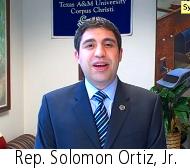Article from: www.thenewspaper.com/news/27/2773.asp
5/11/2009
Texas House Votes to Sunset Red Light Cameras
Texas House of Representatives votes 107-36 to sunset authorization for red light cameras and to lengthen yellow times.
 The Texas House of Representatives voted on Friday to bring an end to the use of red light cameras in the state. During consideration of a bill to reauthorize the Texas Department of Transportation (TxDOT), members debated over 180 amendments to the underlying legislation. Amendment Number 102 added a sunset clause to state approval for the use of automated ticketing machines. This provision passed by a vote of 107-36 and the underlying TxDOT reauthorization measure was adopted on a voice vote.
The Texas House of Representatives voted on Friday to bring an end to the use of red light cameras in the state. During consideration of a bill to reauthorize the Texas Department of Transportation (TxDOT), members debated over 180 amendments to the underlying legislation. Amendment Number 102 added a sunset clause to state approval for the use of automated ticketing machines. This provision passed by a vote of 107-36 and the underlying TxDOT reauthorization measure was adopted on a voice vote.
State Representatives Gary Elkins (R-Houston) and Solomon Ortiz, Jr. (D-Corpus Christi) led the bipartisan effort to forbid cities from entering into any new red light camera contract after June 1 or from extending or renewing any existing contract. As a result, photo enforcement would eventually come to an end in the Lone Star state as contracts generally last no more than two to five years.
It is a close call whether the sunset provision will make it into law, based on the Texas legislature's history with red light cameras. Between 1995 and 2003 the House rejected open attempts to authorize the cameras in four legislative sessions. That did not stop Representative Linda Harper-Brown (R-Irving) who snuck a one-sentence provision allowing municipalities to issue "civil" citations for traffic crimes into unrelated legislation dealing with commercial motor vehicle standards. The provision became law in 2003. Many House members were furious at what they saw as an underhanded move and voted by a three-to-one margin to overturn the provision. The state Senate, however, did not share the enthusiasm of the House. Although a majority of senators voted to strip Harper-Brown's langauge, the Senate leadership allowed the effort to die with a parliamentary maneuver.
Ortiz and Elkins have a backup plan. If the Senate allows photo ticketing to survive, the representatives added another measure to protect drivers from being trapped by short yellows.
"[TxDOT] by rule shall require that the change interval in a light equipped with a photographic traffic signal enforcement system must be at least one second longer than the minimum change interval established in accordance with the Texas Manual on Uniform Traffic Control Devices," the Ortiz-Elkins amendment states.
Already, the states of Ohio and Georgia have enacted longer yellow requirements to great effect. In Georgia, seven cities known to have lengthened yellows since January have seen violations decrease by 70 to 80 percent. A Texas Transportation Institute (TTI) study documented a 40 percent decrease in collisions after testing the benefits of increasing the yellow warning given to motorists before an intersection signal changes from green to red (view study).
A copy of the red light camera amendment is available in a PDF file at the source link below.
Source: Amendment 102 to House Bill 300 (Texas State Legislature, 5/8/2009)
Permanent Link for this item
Return to Front Page
 The Texas House of Representatives voted on Friday to bring an end to the use of red light cameras in the state. During consideration of a bill to reauthorize the Texas Department of Transportation (TxDOT), members debated over 180 amendments to the underlying legislation. Amendment Number 102 added a sunset clause to state approval for the use of automated ticketing machines. This provision passed by a vote of 107-36 and the underlying TxDOT reauthorization measure was adopted on a voice vote.
The Texas House of Representatives voted on Friday to bring an end to the use of red light cameras in the state. During consideration of a bill to reauthorize the Texas Department of Transportation (TxDOT), members debated over 180 amendments to the underlying legislation. Amendment Number 102 added a sunset clause to state approval for the use of automated ticketing machines. This provision passed by a vote of 107-36 and the underlying TxDOT reauthorization measure was adopted on a voice vote.